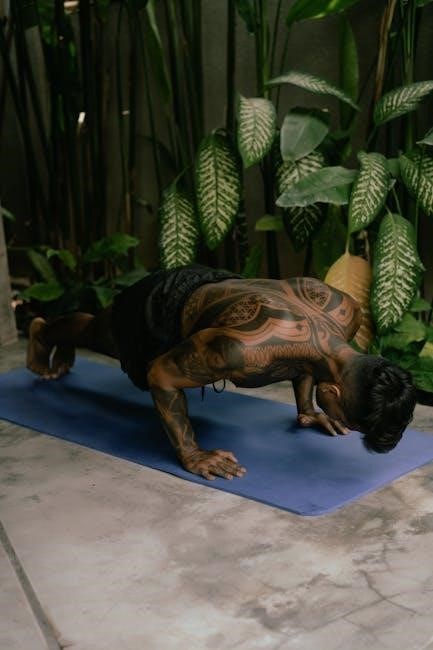Discover the ultimate chest and triceps workout plan designed to maximize muscle growth and strength․ This structured routine with a free PDF guide helps you achieve a powerful upper body through effective exercises and expert tips․
1․1 Importance of Training Chest and Triceps
Training your chest and triceps is essential for building a strong, balanced upper body․ A well-developed chest enhances posture, improves athletic performance, and contributes to overall physical aesthetics․ The triceps, comprising 60% of your arm’s muscle mass, play a crucial role in movements like pushing and extending the elbows․ Strengthening these muscles improves functional strength for daily activities and sports․ Additionally, a strong chest and triceps boost confidence and create a more defined physique․ Incorporating compound exercises like bench presses and dips targets multiple muscle groups, making your workouts efficient and effective for muscle growth and strength development․
1․2 Benefits of a Structured Workout Plan
A structured workout plan ensures consistency and efficiency, helping you achieve your muscle growth and strength goals․ By organizing exercises, sets, and reps, you maximize time and effort, targeting chest and triceps effectively․ A well-designed plan prevents overtraining and injury by balancing intensity with recovery․ It also allows for tracking progress, making adjustments, and staying motivated․ With a clear roadmap, you avoid guesswork and maintain focus․ This approach supports long-term fitness goals, ensuring steady improvements in muscle size and strength․ A structured plan is key to achieving a balanced, powerful upper body, making it indispensable for serious trainers aiming for lasting results․
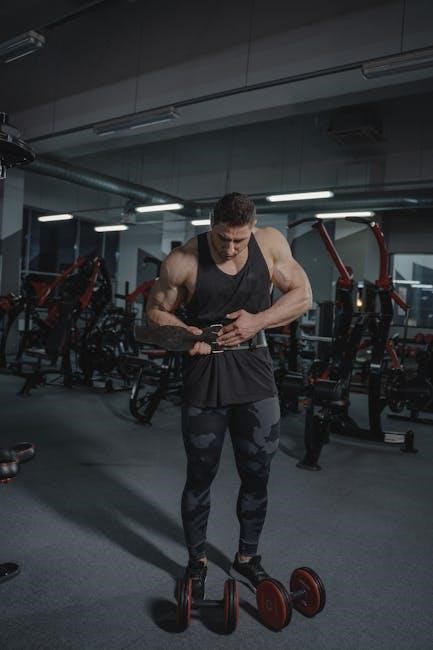
Understanding Chest and Triceps Anatomy
The chest consists of the Pectoralis Major and Pectoralis Minor, while the triceps include three heads of the Triceps Brachii․ Understanding their anatomy enhances targeted training for optimal results․
2․1 Chest Muscles: Pectoralis Major and Minor
The Pectoralis Major is the largest muscle in the chest, responsible for movements like pushing and flexion․ It is further divided into the sternal head (chest origin) and the clavicular head (upper chest)․ The Pectoralis Minor, lying beneath, assists in movements like shoulder forward elevation and scapular rotation․ Together, these muscles contribute to a broader, more defined chest․ Targeting both through exercises like bench presses and incline presses ensures comprehensive development and a balanced aesthetic appearance․
2․2 Triceps Muscles: Three Heads of the Triceps Brachii
The Triceps Brachii consists of three distinct heads: the lateral head, medial head, and long head․ The lateral and medial heads originate from the humerus, while the long head originates from the scapula, contributing to the muscle’s overall size and strength․ Together, these heads extend the elbow and stabilize the shoulder joint, making the triceps crucial for pushing movements and upper body stability․ A well-rounded workout targeting all three heads ensures balanced development, enhancing both functionality and aesthetic appeal․ Effective exercises like close-grip bench presses and dips specifically engage these muscles, promoting hypertrophy and strength gains․

Best Exercises for Chest and Triceps
Effective exercises include bench press, incline bench press, dips, and pec deck fly․ These compound and isolation movements target both muscles for balanced growth and strength development․
3․1 Bench Press: King of Chest Exercises
The bench press is a fundamental exercise for chest development, targeting the pectoralis major while engaging the shoulders and triceps․ It allows for heavy loading, making it ideal for building strength and muscle mass․ Proper form involves lying flat on a bench, gripping the bar slightly wider than shoulder-width, and lowering the bar to the chest before pressing upward․ Variations like the incline bench press and close-grip bench press can further target specific areas of the chest and triceps․ Consistency and progressive overload are key to maximizing results from this exercise․
3․2 Dumbbell Bench Press: Alternatives and Variations
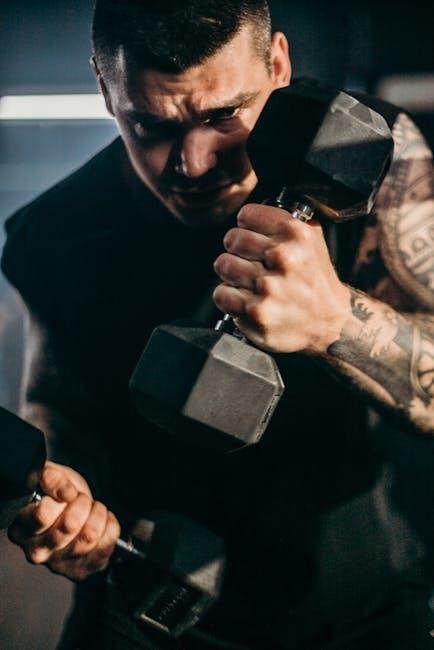
The dumbbell bench press is a versatile alternative to the barbell bench press, offering unique benefits for chest development․ It allows for a greater range of motion, reducing strain on the shoulders while isolating the pectoralis major․ Dumbbells also enable unilateral training, helping to correct strength imbalances between sides․ Variations include the incline dumbbell press, which targets the upper chest, and the neutral grip dumbbell press, which emphasizes tricep activation․ For added intensity, athletes can perform pause reps or negative reps․ This exercise is essential for building a balanced and defined chest, especially for those who prefer or require alternatives to barbell training․
3․3 Incline Bench Press: Targeting the Upper Chest
The incline bench press is a powerful exercise for targeting the upper chest, specifically the clavicular head of the pectoralis major․ By adjusting the bench to a 30-45 degree angle, this variation shifts emphasis from the lower chest to the upper chest, creating a more balanced development․ It also engages the anteriordeltoids and triceps, making it a compound movement․ To maximize results, focus on controlled movement and full range of motion․ Using dumbbells instead of a barbell can allow for greater isolation and reduce shoulder strain․ Incorporating incline presses into your routine ensures a well-rounded chest development and complements flat bench exercises effectively․ Proper form is essential to avoid injury and optimize muscle engagement․
3․4 Close-Grip Bench Press: Focusing on Triceps
The close-grip bench press is an excellent exercise for targeting the triceps, while also engaging the chest and shoulders to a lesser extent․ By narrowing your grip on the barbell, the range of motion shortens, and the emphasis shifts primarily to the triceps․ This variation is particularly effective for building tricep strength and size․ To perform it correctly, grip the bar with your hands 6-8 inches apart, lower the bar to your chest, and press upwards while extending your elbows fully․ Avoid flaring your elbows to minimize shoulder strain․ Incorporating the close-grip bench press into your routine can enhance tricep development and complement other chest-focused exercises effectively․ Consistency and proper form are key to maximizing results․
3․5 Bar Dips: Compound Movement for Chest and Triceps
Bar dips are a highly effective compound exercise that targets both the chest and triceps, making them a staple in upper-body workouts․ By leaning forward slightly during the movement, you can emphasize chest engagement, while keeping your body upright focuses more on the triceps․ This exercise is excellent for building strength and muscle balance․ To perform dips correctly, grip the bar with your hands shoulder-width apart, lower your body until your elbows are bent at 90 degrees, and push back up to the starting position․ Avoid swinging or using momentum, as this can reduce effectiveness and potentially cause injury․ Incorporating bar dips into your routine can enhance both chest and tricep development effectively․ Consistency and proper form are essential for optimal results․
3․6 Pec Deck Fly: Isolation for Chest Development
The Pec Deck Fly is an isolation exercise specifically designed to target the chest muscles, particularly the sternal head of the pectoralis major․ It allows for precise focus on the chest without engaging other muscle groups, making it ideal for shaping and defining the chest․ To perform the Pec Deck Fly, sit upright on the machine with your chest pressed against the pad, grip the handles, and push them outward until your arms are fully extended․ Keep a slight bend in your elbows to avoid joint strain․ Use controlled movements and avoid swinging to maintain tension on the chest muscles․ This exercise is highly effective for achieving a well-rounded chest development when incorporated into your workout routine․
3․7 Cable Fly: High to Low Variation
The Cable Fly: High to Low is a versatile isolation exercise that targets the chest muscles from a unique angle, emphasizing the lower chest․ It involves holding cable handles at shoulder height and pressing them downward in an arcing motion until your arms are fully extended below your chest․ This variation helps in creating a balanced chest development by engaging the sternal and abdominal heads of the pectoralis major․ Keeping the core stable and maintaining controlled movements ensures maximum chest activation․ The Cable Fly complements compound exercises like the bench press and adds variety to your chest workout routine, promoting overall chest definition and shape․

Sample 8-Week Workout Routine
This structured 8-week plan combines chest and triceps exercises, with progressive overload and variation to maximize muscle growth․ It includes supersets, isolation work, and active recovery strategies for optimal results․
4․1 Day 1: Chest and Triceps Superset 1
Start your workout with Superset 1, focusing on chest and triceps․ Perform 4 sets of 10-12 reps for each exercise, resting 2 minutes between sets․ Begin with the dumbbell bench press, ensuring proper form by squeezing your chest muscles at the top․ Pair this with the pec deck fly to target the chest from a different angle․ For triceps, include close-grip bench press or bar dips to engage the three heads of the triceps brachii․ Variations like incline bench press or cable fly can be added for upper chest emphasis․ Supersets maximize intensity and efficiency, promoting muscle growth and strength․ Maintain strict form and progressively increase weights to avoid plateaus․
4․2 Day 1: Chest and Triceps Superset 2
Transition to Superset 2 with a focus on targeting different angles of the chest and triceps․ Begin with the incline bench press (4 sets of 8-10 reps), emphasizing the upper chest muscles․ Pair this with the cable fly (3 sets of 12-15 reps) to isolate the chest and enhance definition․ For triceps, incorporate tricep pushdowns (4 sets of 10-12 reps) and overhead tricep extensions (3 sets of 12-15 reps) to engage all three heads of the triceps brachii․ Rest for 60-90 seconds between exercises and maintain strict form to avoid injury․ This superset combination maximizes muscle engagement and promotes balanced development, ensuring a well-rounded chest and triceps workout․
4․3 Day 1: Triceps Isolation Exercises
Finish Day 1 with isolation exercises to target the triceps specifically․ Start with tricep dips (4 sets of 10-12 reps) using a bench or parallel bars, focusing on controlled lowering and explosive push-ups․ Next, perform overhead tricep extensions (3 sets of 12-15 reps) with a dumbbell or barbell, ensuring full range of motion․ Follow up with tricep kickbacks (4 sets of 12-15 reps) using light weights for precise targeting․ Rest for 60-90 seconds between sets․ These isolation exercises enhance triceps definition and strength, complementing the compound movements from earlier․ Maintain strict form to avoid injury and maximize muscle engagement․
4․4 Day 5: Back and Biceps (Active Recovery)
Day 5 focuses on back and biceps, serving as active recovery while engaging other muscle groups․ Begin with pull-ups (4 sets of 8-10 reps) or assisted variations to target latissimus dorsi․ Follow with bent-over rows (4 sets of 8-12 reps) using a barbell or dumbbells, emphasizing a full range of motion․ For biceps, include barbell curls (4 sets of 10-12 reps) and hammer curls (3 sets of 12-15 reps) to balance development․ Rest for 60-90 seconds between sets․ This day promotes recovery for chest and triceps while maintaining muscle engagement and overall fitness progression․ Keep weights moderate to avoid overexertion, focusing on controlled movements․
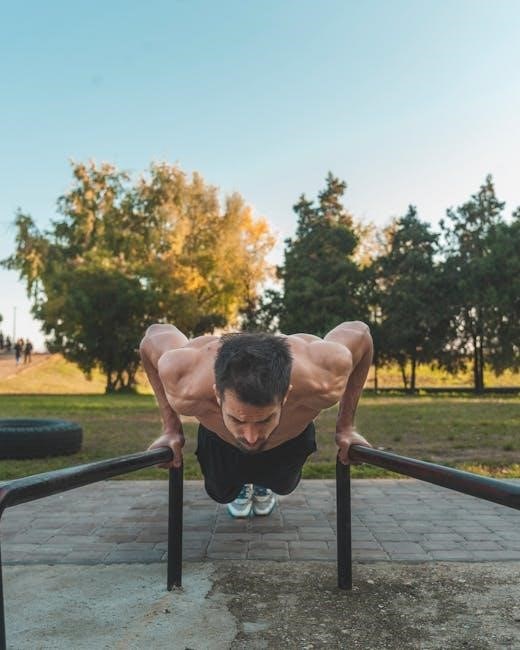
Nutrition and Supplementation
A high-protein diet, balanced with carbs and fats, fuels muscle growth․ Timing meals around workouts and adding supplements like creatine and BCAAs enhances recovery and performance․
5․1 Protein Intake for Muscle Growth
Adequate protein intake is crucial for muscle repair and growth․ Aim for 1․2-2․2 grams of protein per kilogram of body weight daily․ Include lean sources like chicken, fish, and eggs, as well as plant-based options such as beans and tofu․ Post-workout protein shakes can help replenish muscle tissue and promote recovery․ Additionally, distributing protein intake evenly across meals ensures sustained muscle synthesis throughout the day, supporting your chest and triceps development effectively․ Proper hydration and a balanced diet complement protein intake for optimal results․
5․2 Pre- and Post-Workout Meals
Fueling your body with the right nutrients before and after workouts is essential for optimal performance and recovery․ A pre-workout meal should include complex carbs and lean protein, such as oatmeal with banana or eggs, 1-2 hours before training․ Post-workout, consume a protein shake or meal with carbs within 30 minutes to replenish energy stores and support muscle repair․ Examples include Greek yogurt with berries or a chicken and rice bowl․ Staying hydrated is also vital, with water or electrolyte-rich drinks․ Proper meal timing enhances endurance, accelerates recovery, and maximizes muscle growth, ensuring you get the most out of your chest and triceps workouts․
5;3 Role of Creatine and BCAAs
Creatine and BCAAs (branched-chain amino acids) are popular supplements that support muscle growth and recovery․ Creatine increases strength and endurance, allowing for more intense workouts, while BCAAs reduce muscle soreness and promote recovery․ Consuming BCAAs during or after training can help prevent muscle breakdown and accelerate repair․ Creatine is best taken consistently, with a loading phase of 20-25 grams daily for the first week, then 3-5 grams thereafter․ Both supplements complement a well-structured workout plan, enhancing performance and recovery for chest and triceps training․ Always consult a healthcare professional before starting any supplementation regimen to ensure safety and effectiveness․
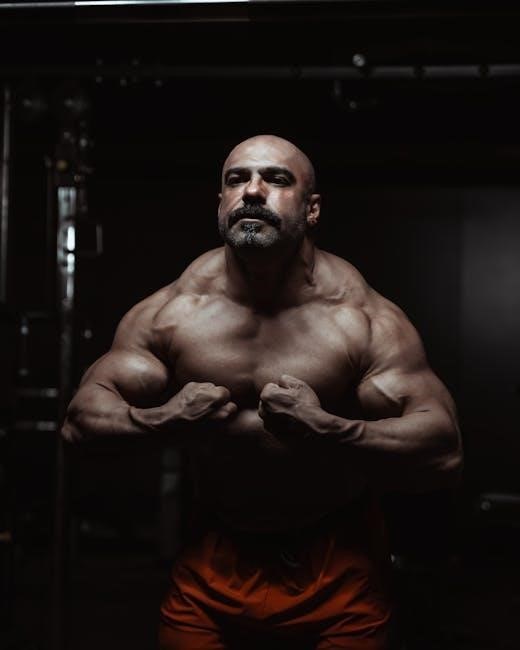
Recovery and Rest
Proper hydration, quality sleep, and rest days are crucial for muscle recovery and growth․ These elements ensure your chest and triceps repair and strengthen effectively after workouts․
6․1 Importance of Rest Days
Rest days are essential for muscle recovery and growth, allowing your chest and triceps to repair and strengthen after intense workouts․ During rest, your muscles adapt and rebuild, preventing overtraining and injury․ Neglecting rest can lead to fatigue, decreased performance, and potential harm to your progress․ Schedule rest days strategically to ensure optimal recovery and muscle growth․ This period also allows your central nervous system to recover, enhancing future workout efficiency․ Proper rest supports overall fitness goals, ensuring long-term consistency and progress in your chest and triceps training․
6․2 Hydration and Sleep for Muscle Recovery
Hydration plays a critical role in muscle recovery by transporting nutrients and removing waste products from cells․ Even mild dehydration can impair performance and slow recovery․ Aim to drink plenty of water throughout the day, especially before, during, and after workouts․ Sleep is equally vital, as it’s during deep sleep that your body repairs and grows muscle tissue․ Aim for 7-9 hours of quality sleep nightly to support recovery․ Poor sleep quality can hinder muscle growth and reduce physical performance․ Prioritizing hydration and sleep ensures your chest and triceps recover effectively, allowing you to train consistently and achieve your fitness goals․
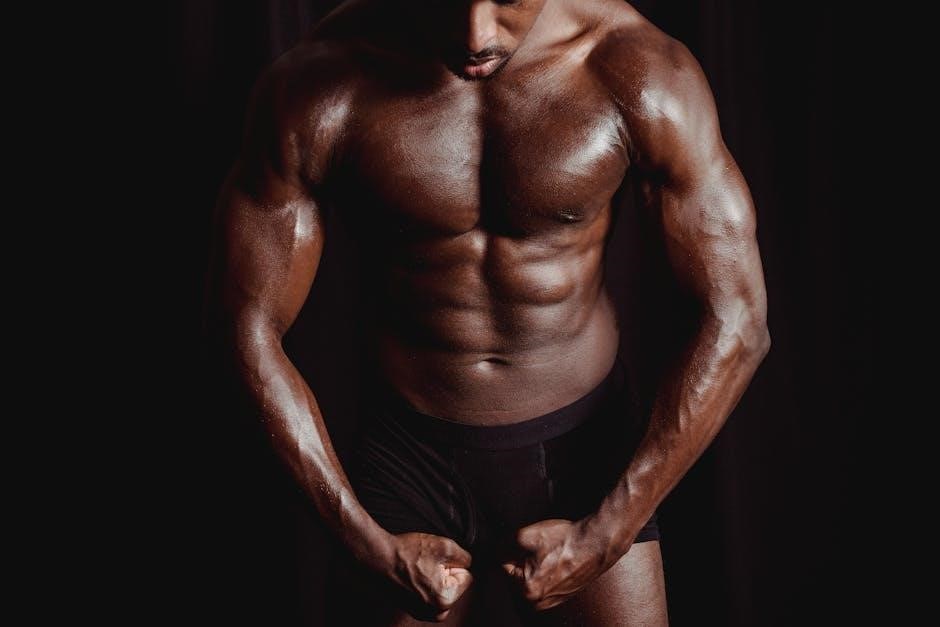
Downloadable PDF Guide
Download the free chest and triceps workout PDF guide for a comprehensive and organized plan․ Includes exercises, sets, reps, and nutrition tips to maximize your results․
7․1 What’s Included in the PDF
The downloadable PDF guide offers a detailed 8-week workout plan, including exercises, sets, reps, and rest periods․ It covers chest and triceps exercises like bench presses, incline presses, and dips․ Additionally, it provides nutrition advice, such as protein intake recommendations and meal timing strategies․ The guide also emphasizes recovery techniques, hydration, and sleep optimization․ A printable schedule helps track progress, while tips for beginners ensure proper form and technique․ This comprehensive resource is designed to help users achieve their fitness goals efficiently and safely․
7․2 How to Use the PDF for Maximum Results
To maximize results with the chest and triceps workout PDF, start by setting clear fitness goals and tracking progress weekly․ Follow the structured 8-week plan, ensuring consistency in workouts and nutrition․ Prioritize proper form and technique to prevent injuries and optimize muscle engagement․ Incorporate the recommended warm-up and stretching routines to enhance performance and recovery․ Stay hydrated, maintain adequate sleep, and adhere to the nutrition guidelines for muscle growth․ Review and adjust the plan as needed to keep challenging your muscles․ Consistency and dedication are key to achieving the best outcomes with this comprehensive guide․
Tips for Beginners
Start with light weights and focus on proper form to prevent injuries․ Gradually increase intensity and consistency to build strength and confidence․ Rest adequately between sets․
8․1 Starting with Light Weights
Beginners should start with lighter weights to master proper form and technique․ This approach reduces injury risk and builds a strong foundation․ Focus on controlled movements and full range of motion to engage muscles effectively․ Gradually increase weight as strength improves․ Prioritize consistency and patience over heavy loads initially․
8․2 Focus on Form and Technique
Proper form and technique are crucial for effective and safe workouts․ Always prioritize controlled movements over heavier weights to prevent injuries and ensure muscles are targeted correctly․ Avoid sacrificing form for heavier loads, as this can lead to imbalances and poor results․ Focus on full range of motion and engage the correct muscle groups․ For chest exercises like bench presses, maintain a stable core and lower the weight slowly․ For triceps, ensure elbows track properly to avoid strain․ Seek guidance from trainers or online resources to master techniques․ Consistent practice of proper form builds a strong foundation for progress and maximizes results․
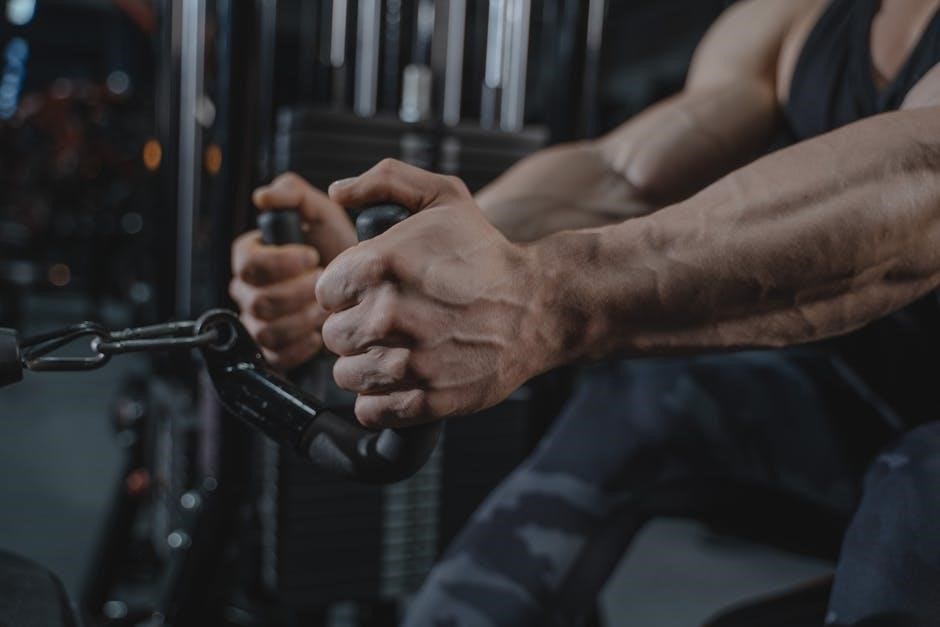
Advanced Training Techniques
Boost your workout intensity with advanced techniques like DTP training and Giant Sets, designed to challenge experienced lifters and maximize muscle engagement for superior results․
9․1 DTP Training: Dynamic Tempo Programming
DTP (Dynamic Tempo Programming) is an advanced training method that combines varied tempos with traditional sets and reps to maximize muscle engagement and intensity․ This technique involves slow, controlled movements during the eccentric phase, followed by explosive concentric phases, which enhances strength and muscle growth․ For chest and triceps, DTP can be applied to exercises like the bench press or dips, with tempos such as 4-2-1 (4 seconds lowering, 2 seconds pause, 1 second lift)․ Incorporating DTP into your routine challenges muscle fibers differently, promoting hypertrophy and functional strength․ It’s ideal for experienced lifters seeking to break plateaus and achieve superior results․
9․2 Giant Sets for Increased Intensity
Giant sets are a high-intensity training technique involving 3-5 exercises performed consecutively with minimal rest, targeting the same muscle group․ For chest and triceps, examples include bench press, incline press, and dips in rapid succession․ This method increases time efficiency, boosts metabolic stress, and enhances muscle endurance․ By minimizing rest periods, giant sets amplify the workout’s intensity, pushing muscles to their limits․ They are ideal for advanced lifters seeking to break plateaus and maximize hypertrophy․ Incorporate giant sets into your routine for a challenging and effective way to elevate your chest and triceps workouts to the next level․

Avoiding Common Mistakes
Avoid overtraining and neglecting proper form to prevent injuries․ Ensure adequate warm-ups and stretching to maintain muscle health and optimal workout performance․
10․1 Overtraining: Signs and Solutions
Overtraining can hinder progress and lead to injuries․ Signs include persistent fatigue, decreased performance, and increased muscle soreness․ To address this, ensure adequate rest days, balance workout intensity, and maintain proper nutrition․ Incorporating recovery techniques like stretching and hydration can also help․ Listen to your body and adjust your routine to avoid burnout, ensuring long-term muscle growth and overall health․
10․2 Neglecting Stretching and Warm-Up
Neglecting stretching and warm-up can lead to injuries and reduce workout efficiency․ Always begin with a 5-10 minute dynamic warm-up to prepare muscles and joints․ Post-workout stretching improves flexibility and reduces soreness․ Incorporating these routines ensures better performance and faster recovery, keeping you consistent and injury-free in your chest and triceps training journey․
